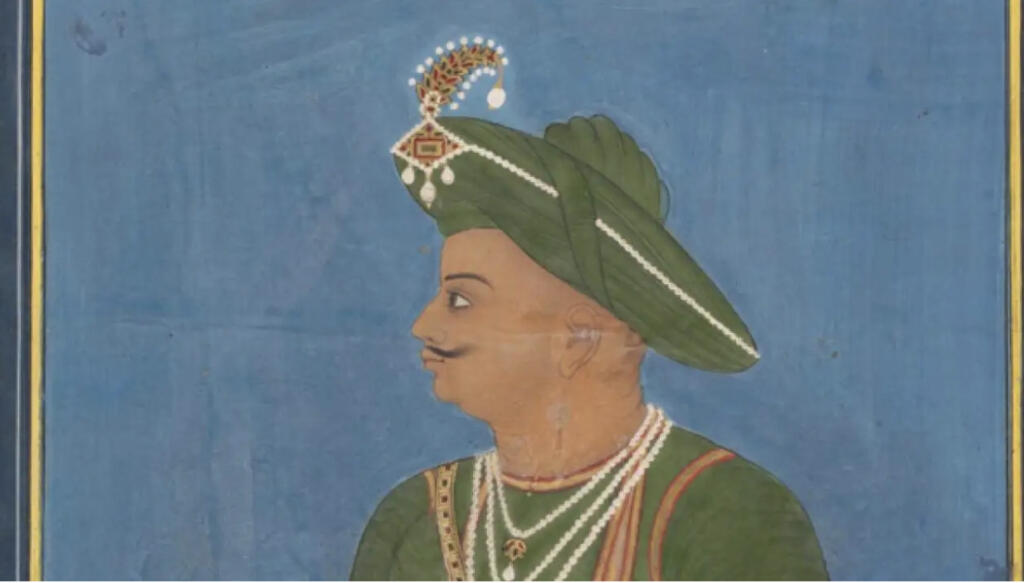Tipu, the erstwhile ruler of Mysuru has long been glorified in India’s history books, published by Marxist and left historians, and he has been projected as some sort of a warrior par excellence, whose match could not be met by the mightiest of the mighty. This is an all-out farce. It is incredulous for anybody to agree with assertions of Tipu Sultan being a secular, inclusive and peaceful leader, let alone him being a warrior. Tipu Sultan, in reality, was a cold-blooded barbarian, genocide enabler, and a coward while at it. Tipu’s cowardice is what cost him many wars – most of which he lost, and almost all of which ended up extracting a heavy price from his kingdom.
On Saturday, Srinivas BV, who is the National President of the Indian Youth Congress shared a photoshopped image of Chhatrapati Shivaji Maharaj to wish Tipu Sultan on his birth anniversary. Srinivas shared a popular picture portraying Chhatrapati Shivaji Maharaj sitting atop a rearing horse. The face of Chhatrapati was removed, and that of Tipu Sultan was superimposed. Thereupon, Srinivas went on to wish Tipu Sultan a happy birthday.
The Congress leader wrote, “Remembering ‘The Tiger of Mysore’ #TipuJayanti who fought valiantly against British colonialism, on his birth anniversary today.”
.@srinivasiyc photoshopped Tipu Sultan's face on Chhatrapati Shivaji Maharaj. Disgusting!! pic.twitter.com/DRMGakHEtO
— Facts (@BefittingFacts) November 20, 2021
Tipu Sultan’s Hatred for Hindus
The glorification of Tipu began with the controversial novel titled “The sword of Tipu Sultan” by Bhagwan Gidwani. Here’s the reality of this coward’s sword. The incisive truth about the sword of Tipu is that it carried an inscription in Persian stating: “My victorious Sabre is lightning for the destruction of the non-believers. Thou art our Lord, make him victorious who promotes the faith of Muhammad. Confound him, who refuses the faith of Muhammad and withhold us from those who are so inclined”.
Tipu Sultan in 1783 during his siege of Palghat Fort had scaled new heights of savagery where “Tipu’s soldiers daily exposed the heads of many innocent Brahmins within sight from the fort for Zamorin and his Hindu followers to see.”
Tipu had even proclaimed: “It is our constant object and sincere intention that those worthless and stiff-necked infidels (Hindus) who have turned aside their heads from obedience to the true believers, and openly raised the standard of infidelity should be chastised by the hands of the faithful and made either to acknowledge the true religion or to pay tribute.”
His notices to commanders and allies read, “you will do whatever may be in your power to increase the lustre of the firm religion” and “the army of the accursed infidels has been trodden underfoot by the hoofs of the horses of Islam and rendered vile and miserable, while the religion of Mohammed has been thereby made to flourish. You, Sir, will, therefore, apply with all your heart the best means of advancing the religion of Mohammed and of administering to the support of Islam.” Even Tipu’s own court bard, Kirmani, concedes, “He (Tipu) had, however, a great dislike to, or rather, an abhorrence of the people of other religions”.
When Hindus Humiliated Tipu Sultan
The glorification of Tipu would have anybody believe that he was a great warrior who never lost a war. The reality, however, is quite the opposite. Starting from 1767, the Kingdom of Mysore had fought four major military confrontations, all of which were largely unsuccessful and the outcomes ultimately disastrous.
The most decisive really was the war between Tipu Sultan and Marathas. Under Peshwa Madhavrao I, the Kingdom of Mysore, which was then ruled by Tipu Sultan’s father was forced to accept the Maratha Empire as the supreme power in 1764 and then again in 1767. In 1767, Maratha Peshwa Madhavrao defeated both Hyder Ali and Tipu Sultan and entered Srirangapatna, the capital of Mysore.
Read more: Tipu Sultan, the celebrated tyrant of Congress
Interestingly, being the conniving bigot that he was, Tipu Sultan worked to take back the forts of Mysore which had been captured by the Marathas. This brought Tipu in direct conflict with the Marathas, leading to the Maratha–Mysore War. This ended in a humiliating defeat for Tipu, as he lost close to everything, and had to accept the supremacy of the Maratha empire once again. Tipu had to pay an annual tribute of 12 lakhs per year to the Marathas, thus ending hostilities with them. The Maratha-Mysore war ended in April 1787, following the finalizing of the treaty of Gajendragad, as per which, Tipu Sultan of Mysore was obligated to pay 4.8 million rupees as a war cost to the Marathas, and an annual tribute of 1.2 million rupees.
Additionally, Tipu Sultan was also whacked by the British in more ways than one. After his surrender to the British in the aftermath of the Third Anglo-Mysore War, he was forced to cede half his territories to the allies, and deliver two of his sons as hostages until he paid three crores and thirty lakh rupees fixed as war indemnity to the British for the campaign against them. Subsequently, during the Fourth Anglo-British War, Tipu Sultan was killed.
As is evident, Tipu Sultan was no warrior. He was a loser who could not handle one-on-one fights. Even today, his fans are forced to use Photoshop as a formidable tool to show the supposed greatness of their icon.
